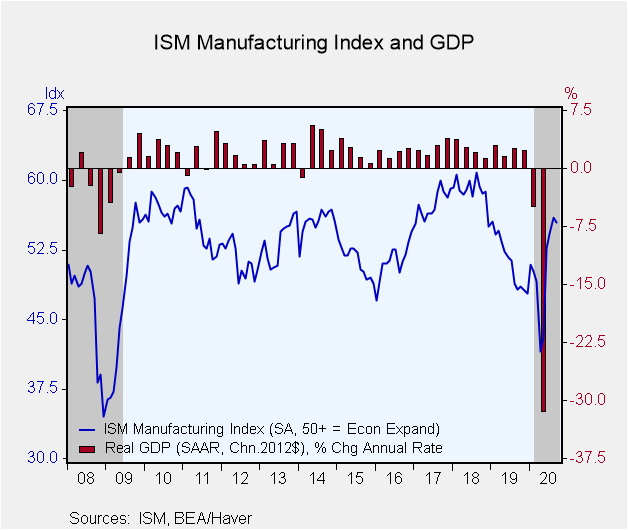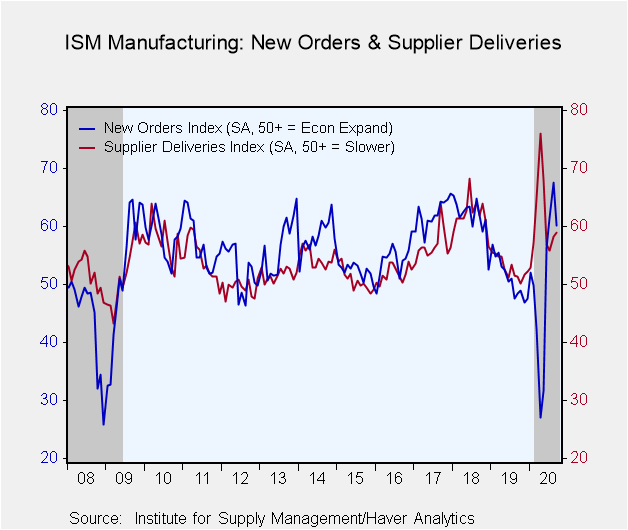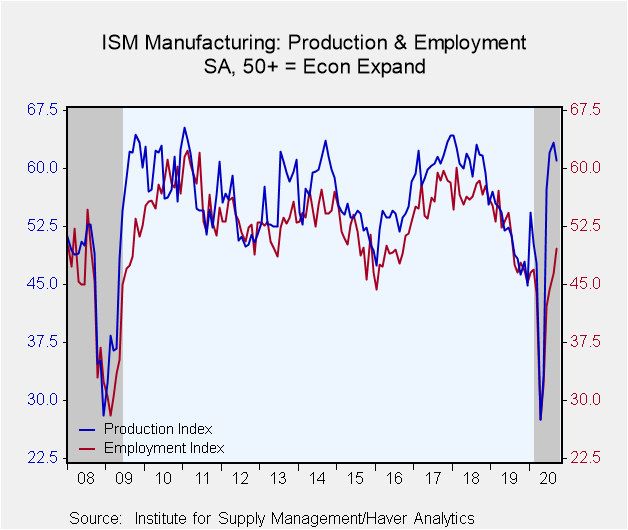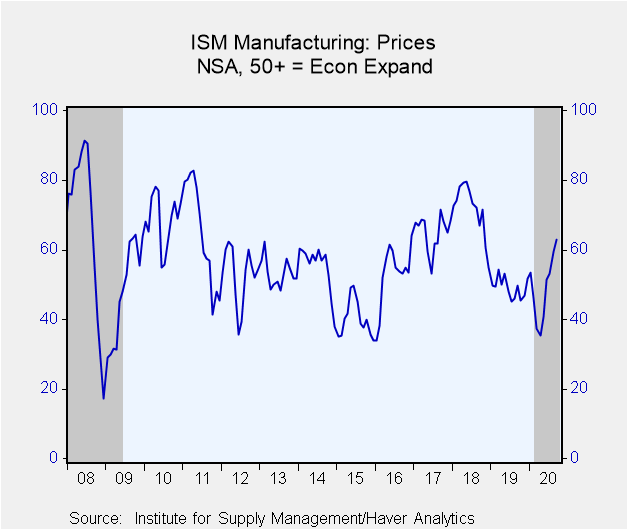 Global| Oct 01 2020
Global| Oct 01 2020ISM Manufacturing Index Slips During September
by:Tom Moeller
|in:Economy in Brief
Summary
• Factory sector activity backpedals modestly. • Components are mixed. • Price index continues to increase. The recent improvement in factory sector activity moderated last month. The Institute for Supply Management (ISM) reported [...]
• Factory sector activity backpedals modestly.
• Components are mixed.
• Price index continues to increase.
The recent improvement in factory sector activity moderated last month. The Institute for Supply Management (ISM) reported that its Composite Index of Manufacturing Sector Activity eased to 55.4 during September after rising for four consecutive months to 56.0 in August. Stability month-to-month was expected in the Action Economics Forecast Survey. It was the fourth consecutive month above the break-even level of 50 after indicating activity declines from March through May. During the last 15 years, there has been a 49% correlation between the composite index and the quarterly change in real GDP.
The new orders index weakened to 60.2 from 67.6. A lessened 35% (NSA) of survey respondents reported higher new orders while a higher 19% reported a decline. The production index fell to 61.0 from 63.3 in August. A lessened 34% (NSA) of respondents reported higher production while a slightly higher 15% reported a decline. Countering these declines was a higher supplier deliveries measure which rose to 59.0, the slowest rate of order fulfillment in four months. The inventories measure also rose to 47.1, its highest level in three months.
Also increasing during September was the employment measure to 49.6 from 46.4 in August. That was increased from 27.5 in April and was the highest point since July of 2019. The index peaked at 60.1 in February 2018. An increased 19% (NSA) of respondents reported higher payrolls while a lessened 22% reported declines.
Improved pricing power has developed as activity continues to improve. The prices paid index increased to 62.8 (NSA). That was increased from April's low of 35.3 and was the highest level since October 2018. An improved 32% of respondents reported higher prices while 7% reported declines.
Other series in the ISM report indicated improvement. The export order measure strengthened to 54.3 from 53.3. It was the highest level in exactly two years, increased from a low of 35.3 in April. The import series eased to 54.0, its third consecutive month above the break-even level of 50. The order backlog measure strengthened to the highest level in roughly two years.
The ISM figures are based on responses from over 400 manufacturing purchasing executives from 20 industries, which correspond to their contribution to GDP in 50 states. These data are diffusion indexes where a reading above 50 indicates expansion. The figures from the Institute for Supply Management can be found in Haver's USECON database; further detail is found in the SURVEYS database. The expectations number is available in Haver's AS1REPNA database.
| ISM Mfg (SA) | Sep | Aug | Jul | Sep'19 | 2019 | 2018 | 2017 |
|---|---|---|---|---|---|---|---|
| Composite Index | 55.4 | 56.0 | 54.2 | 48.2 | 51.2 | 58.9 | 57.4 |
| New Orders | 60.2 | 67.6 | 61.5 | 48.5 | 51.1 | 61.6 | 62.1 |
| Production | 61.0 | 63.3 | 62.1 | 48.4 | 51.2 | 60.9 | 60.9 |
| Employment | 49.6 | 46.4 | 44.3 | 46.5 | 50.9 | 56.9 | 56.8 |
| Supplier Deliveries | 59.0 | 58.2 | 55.8 | 51.3 | 52.9 | 62.0 | 56.8 |
| Inventories | 47.1 | 44.4 | 47.0 | 46.3 | 49.8 | 52.9 | 50.4 |
| Prices Paid Index (NSA) | 62.8 | 59.5 | 53.2 | 49.7 | 49.1 | 71.7 | 65.0 |
Tom Moeller
AuthorMore in Author Profile »Prior to joining Haver Analytics in 2000, Mr. Moeller worked as the Economist at Chancellor Capital Management from 1985 to 1999. There, he developed comprehensive economic forecasts and interpreted economic data for equity and fixed income portfolio managers. Also at Chancellor, Mr. Moeller worked as an equity analyst and was responsible for researching and rating companies in the economically sensitive automobile and housing industries for investment in Chancellor’s equity portfolio. Prior to joining Chancellor, Mr. Moeller was an Economist at Citibank from 1979 to 1984. He also analyzed pricing behavior in the metals industry for the Council on Wage and Price Stability in Washington, D.C. In 1999, Mr. Moeller received the award for most accurate forecast from the Forecasters' Club of New York. From 1990 to 1992 he was President of the New York Association for Business Economists. Mr. Moeller earned an M.B.A. in Finance from Fordham University, where he graduated in 1987. He holds a Bachelor of Arts in Economics from George Washington University.










